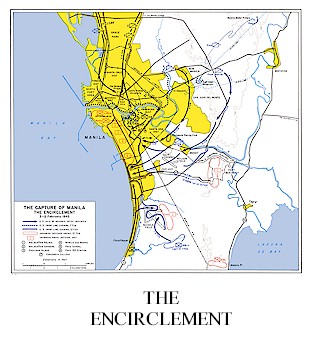When XIV Corps reached Manila on 3 February, no definite
Allied plan existed for operations in the metropolitan area other than the
division of the northern part of the city into offensive zones. Every
command in the theater, from MacArthur's headquarters on down, hoped--if it
did not actually anticipate--that the city could be cleared quickly and
without much damage. GHQ SWPA had even laid plans for a great victory
parade, à la Champs Elysées, that the theater commander in person was to
lead through the city.1
Intelligence concerning Manila and its environs had been
pretty meager, and it was not until the last week or so of January that GHQ
SWPA and Sixth Army began to receive definite reports that the Japanese
planned to hold the city, although General Krueger had felt as early as the
middle of the month that the capital would be strongly defended.2 The
late January reports, often contradicting previous information that had been
supplied principally by guerrillas, were usually so contradictory within
themselves as to be useless as a basis for tactical planning. Thus, much of
the initial fighting was shadowboxing, with American troops expecting to
come upon the main body of the Japanese around each street corner. Only when
the troops actually closed with the principal strongpoints did they discover
where the main defenses were. When XIV Corps began to learn of the extent
and nature of the defenses, the plans for a big victory parade were quietly
laid aside--the parade never came off. The corps and its divisions thereupon
began developing tactical plans on the spot as the situation dictated.
In an effort to protect the city and its civilians, GHQ
SWPA and Sixth Army at first placed stringent restrictions upon artillery
support fires and even tighter restrictions upon air support operations. The
Allied Air Forces flew only a very few strikes against targets within the
city limits before General MacArthur forbade such attacks, while artillery
support was confined to observed fire upon pinpointed targets such as
Japanese gun emplacements.
These two limitations were the only departures from
orthodox tactics of city fighting. No new doctrines were used or
developed--in the sense of "lessons learned," the troops again illustrated
that established U.S. Army doctrine was sound. Most troops engaged had had
some training in city fighting, and for combat in Manila the main problem
was to adapt the mind accustomed to jungle warfare to the special conditions
of city operations. The adjustment was made rapidly and completely at the
sound of the first shot fired from a building within the city.
The necessity for quickly securing the city's water
supply facilities and electrical power installations had considerable
influence on tactical planning.3 Considering
the sanitation problems posed by the presence of nearly a million civilians
in the metropolitan area, General Krueger had good reason to be especially
concerned about Manila's water supply. Some eighty artesian or deep wells in
the city and its suburbs could provide some water, but, even assuming that
these wells were not contaminated and that pumping equipment would be found
intact, they could meet requirements for only two weeks. Therefore, Krueger
directed General Griswold to seize the principal close-in features of the
city's modern pressure system as rapidly as possible.
Establishing priorities for the capture of individual
installations, Sixth Army ordered XIV Corps to secure first Novaliches Dam,
at the southern end of a large, man-made lake in rising, open ground about
two and a half miles east of the town of Novaliches. (See Map
"The Approach to Manila") Second came the Balara Water Filters, about five miles northeast of
Manila's easternmost limits and almost seven miles east of Grace Park. (See Map
"The Encirclement")
 Third was the San Juan Reservoir, on high ground nearly two miles
northeast of the city limits. Fourth were the pipelines connecting these
installations and leading from them into Manila. Ultimately, Sixth Army
would secure other water supply facilities such as a dam on the Marikina
River northeast of Manila, but not until it could release men for the job
from Manila or other battlegrounds on Luzon.
Third was the San Juan Reservoir, on high ground nearly two miles
northeast of the city limits. Fourth were the pipelines connecting these
installations and leading from them into Manila. Ultimately, Sixth Army
would secure other water supply facilities such as a dam on the Marikina
River northeast of Manila, but not until it could release men for the job
from Manila or other battlegrounds on Luzon.
XIV Corps would secure portions of the electrical power
system at the same time its troops were capturing the water supply
facilities. During the Japanese occupation much of the power for Manila's
lights and transportation had come from hydroelectric plants far to the
south and southeast in Laguna Province, for the Japanese had been unable to
import sufficient coal to keep running a steam generator plant located
within the city limits. It appeared that Laguna Province might be under
Japanese control for some time to come, and it could be assumed that the
hydroelectric plants and the transmission lines would be damaged. Therefore,
Sixth Army directed XIV Corps to secure the steam power plant, which was
situated near the center of the city on Provisor Island in the Pasig.
XIV Corps was also to take two transmission substations
as soon as possible. One was located in Makati suburb, on the south bank of
the Pasig about a mile southeast of the city limits; the other was presumed
to be on the north bank of the river in the extreme eastern section of the
city. It is interesting commentary on the state of mapping, considering the
number of years that the United States had been in the Philippines, that the
second substation turned out to be a bill collecting office of the Manila
Electric Company.


